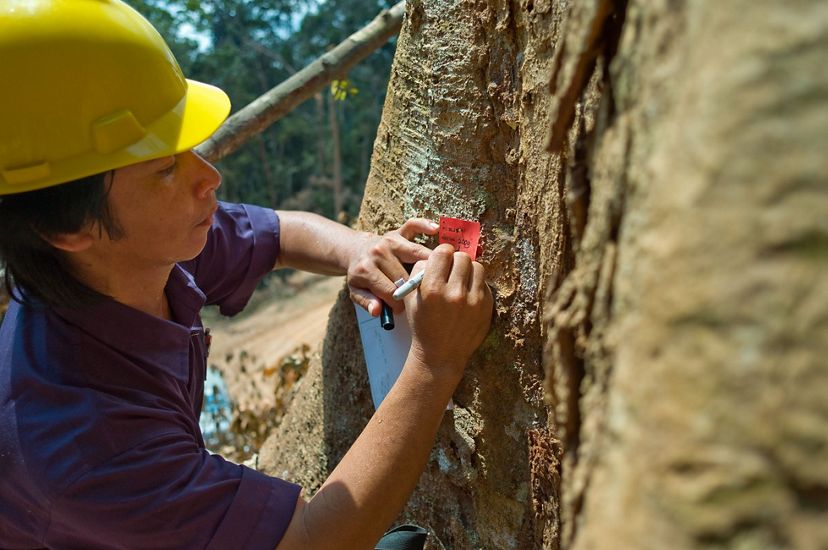Justin Adams is the Global Managing Director, Lands, The Nature Conservancy, and Sophie Beckham is Senior Manager, Natural Capital Stewardship, International Paper.
After decades of anti-deforestation campaigns, many of us may think twice before buying forest products. But is wood use inherently problematic? Forest products are a renewable resource; and if they come from sustainably managed operations—and waste is minimized—wood use is far from an environmental crime. Research also shows that well-managed forests often can store as much carbon as unmanaged forests, making innovative forest management methods a key solution to fighting climate change while supporting local communities and making a profit.
In fact, there is increasing evidence that one of the best ways to protect forests is to use them—about half of the planet’s remaining natural forests are managed for production purposes. A viable forest-based economy means more forests. More well-managed forests mean more carbon sequestered from the atmosphere—and that means a better chance at mitigating climate change. This means that the potential for alliances between the conservation and the forest product sectors is significant.
One such alliance is forming between our own organizations: International Paper and The Nature Conservancy (TNC). Our collaboration, announced on April 17, focuses on the role of reduced-impact logging for carbon (RIL-C), a set of practices pioneered by TNC that balance the economic needs of forest-based communities and businesses with environmental goals, especially climate mitigation.
RIL-C practices—such as reducing the width of forest roads, leaving hollow trees standing or cutting down trees in a specific direction to create less collateral damage—have a surprising impact on reducing emissions. In Indonesia, a recent independent audit report found a 50 percent reduction in CO2 emissions from logging by a commercial operator that adopted RIL-C practices across its concession. Some countries, including Indonesia and Gabon, are considering adopting RIL-C practices as part of their national climate reduction plans in support of the Paris Agreement.
Sustainable forestry as a climate solution
Carbon storage is just one of many benefits provided by the world’s forests—with the right techniques, managed forests filter air and water and provide a home for a diverse range of species. This carbon storage benefit is of a significant scale. TNC-led research published in 2017 indicates that forests offer the single largest "natural climate solution"—the conservation, restoration and improved land-management techniques that increase carbon storage or avoid greenhouse-gas emissions in landscapes worldwide.
Quote
TNC-led research published in 2017 indicates that forests offer the single largest natural climate solution.
RIL-C offers one of the best ways to maximize these solutions while still meeting consumer demand for wood products. Research conducted by a team of scientists, including from TNC, shows that selective logging can retain 85–100 percent of a forest’s biodiversity and at least 75 percent of its carbon. Creating more well-managed forests, such as those employing RIL-C practices, is important because reducing logging in one area doesn’t typically reduce the demand for wood products—but shifts it to other areas, often in the form of illegal logging. In other words, one of the best forms of forest protection is improving the way forests are managed.
Sustainable forestry as a business solution
There is a business opportunity in adopting RIL-C practices. Smarter ways of managing working forests can improve their productivity, just as they can benefit the climate. Removing competing vegetation, more sensitive logging practices that minimize damage to the forest and longer cycles between harvests can promote tree growth.
The collaboration between International Paper and TNC is aimed at expanding the use of RIL-C in critical areas of the tropics, and, as possible, integrating the RIL-C methodology with forest certification, thereby strengthening the climate aspect of certification, in particular with the Forest Stewardship Council. With consumer demand growing for more sustainable products, companies that are able to attain such certifications will be better positioned to meet this demand.
Quote
With consumer demand growing for more sustainable products, companies that are able to attain such certifications will be better positioned to meet this demand.
The funding provided by International Paper will help develop RIL-C "toolkits" for various tropical regions. The projects are starting in the rich and dense ecosystems of tropical forests because they are particularly effective carbon sinks. That said, this work is also potentially applicable in temperate areas—particularly in higher diversity deciduous temperate forests, such as the Central Appalachians, where there are opportunities for improvements in harvesting practices.
The toolkits will include carbon emissions measurement guidelines to detect various levels of forest degradation and impacts on biodiversity. Many forest operations haven’t yet made room to include carbon emission values in project plans and evaluations. But successful forest management isn’t just about the number of trees standing. By accounting for carbon emissions data as well, forest managers will have a more detailed and accurate snapshot of a forest’s environmental role and economic potential.
With this work to expand the use of RIL-C, and align RIL-C and credible forest certification, TNC and International Paper hope to expand sustainable, climate-smart forestry in critical forested geographies. Better forest management is our planet’s most promising natural climate solution and in the context of our partnership, it is both a conservation and a business strategy. Forests clean our air and water, provide economic well-being for communities, support biodiversity, provide forest products that people depend on every day—and serve as the world’s oldest and most proven carbon storage technology. That’s definitely something worth talking about.
Originally Posted on GreenBiz
April 19, 2018
View Original
Global Insights
Check out our latest thinking and real-world solutions to some of the most complex challenges facing people and the planet today.
